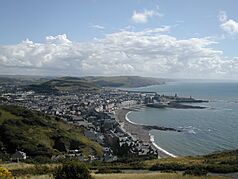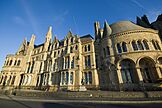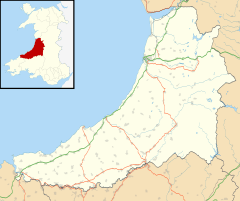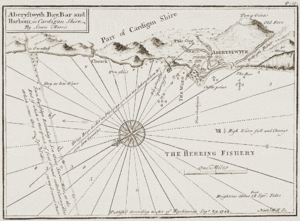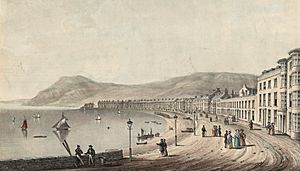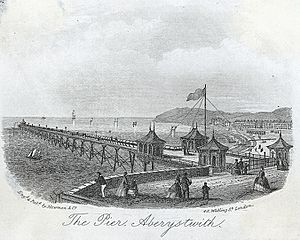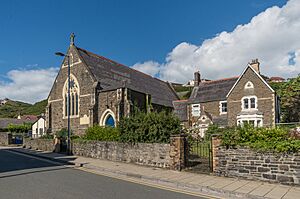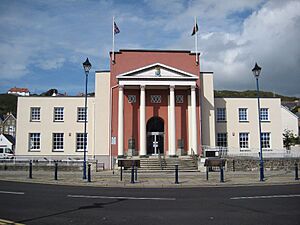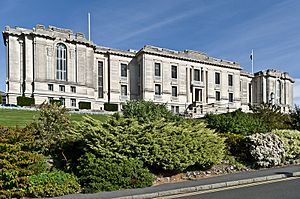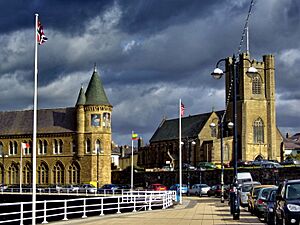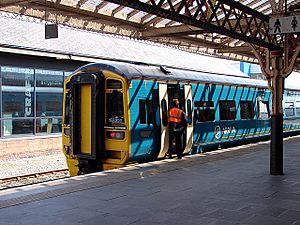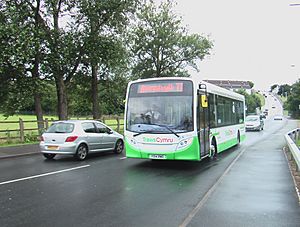Aberystwyth facts for kids
Quick facts for kids Aberystwyth |
|
|---|---|
|
|
|
| Population | 14,640 (2021) |
| OS grid reference | SN585815 |
| • Cardiff | 90 mi (140 km)SE |
| Principal area | |
| Ceremonial county | |
| Country | Wales |
| Sovereign state | United Kingdom |
| Post town | ABERYSTWYTH |
| Postcode district | SY23 |
| Dialling code | 01970 |
| Police | Dyfed-Powys |
| Fire | Mid and West Wales |
| Ambulance | Welsh |
| EU Parliament | Wales |
| UK Parliament |
|
| Welsh Assembly |
|
| Website | www.aberystwyth.gov.uk |
Aberystwyth is a lively university and seaside town in Ceredigion, Wales. It's the biggest town in Ceredigion, located about 16 miles from Aberaeron. In 2021, around 14,640 people lived here.
The name Aberystwyth means "the mouth of the Ystwyth" in Welsh. This town has been an important place for education in Wales since Aberystwyth University opened in 1872. It sits on Cardigan Bay on the west coast of Wales, where the River Ystwyth and Afon Rheidol meet the sea. The town's beautiful seafront has a pier and stretches from Constitution Hill to the harbour.
Contents
- Discovering Aberystwyth: What to See and Do
- Aberystwyth's Weather: A Quick Look
- Aberystwyth's Long History
- Aberystwyth's Location and Surroundings
- How Aberystwyth is Governed
- Culture and Arts in Aberystwyth
- Sports in Aberystwyth
- The Welsh Language in Aberystwyth
- Churches in Aberystwyth
- Education in Aberystwyth
- Tourism and Jobs in Aberystwyth
- Getting Around Aberystwyth: Transport
- Famous People from Aberystwyth
- Aberystwyth in Stories
- Honors for Aberystwyth
- Sister Cities
- See also
Discovering Aberystwyth: What to See and Do
Aberystwyth is a popular spot for both students and tourists. It connects North Wales and South Wales culturally.
- Constitution Hill: You can ride the Aberystwyth Cliff Railway (a funicular railway) up this hill for amazing views of the town and bay. At the top, there's a camera obscura, which is a cool optical device that projects a live image of the surroundings.
- Nature and Scenery: Close to town, you can explore the wild Cambrian Mountains. Their valleys have forests and meadows that look almost the same as they did centuries ago.
- Vale of Rheidol Railway: A great way to see the countryside is by taking a ride on the old narrow-gauge Vale of Rheidol Railway steam train.
Even though much of the town looks modern, it has many historic buildings. These include the ruins of Aberystwyth Castle and the Old College building of Aberystwyth University. The Old College was first built as a hotel in 1865. But the owner went bankrupt, and the building was sold to the university in 1867.
The main university campus is now on Penglais Hill, overlooking Aberystwyth. The train station, built in 1924, has a mix of old architectural styles.
Aberystwyth is like the unofficial capital of Mid Wales. Many important Welsh organizations have offices here. These include the National Library of Wales, which keeps important Welsh books, maps, and records. The Royal Commission on the Ancient and Historical Monuments of Wales also has its base here, helping people learn about Wales's historic buildings.
Aberystwyth's Weather: A Quick Look
Aberystwyth has an oceanic climate, which means its weather is influenced by the sea. This is because it's on the west coast of Wales, facing the Irish Sea. The sea helps keep temperatures mild.
- Warmest Day: The highest temperature ever recorded was 34.6°C (94.3°F) in July 2006.
- Coldest Day: The lowest temperature was -13.5°C (7.7°F) in January 2010.
- Rainfall: On average, it rains about 1112 mm (43.8 inches) each year.
| Climate data for Gogerddan, elevation 31m, 1981–2010, extremes 1960– | |||||||||||||
|---|---|---|---|---|---|---|---|---|---|---|---|---|---|
| Month | Jan | Feb | Mar | Apr | May | Jun | Jul | Aug | Sep | Oct | Nov | Dec | Year |
| Record high °C (°F) | 16.1 (61.0) |
17.8 (64.0) |
22.8 (73.0) |
26.2 (79.2) |
27.5 (81.5) |
31.7 (89.1) |
34.6 (94.3) |
32.8 (91.0) |
31.1 (88.0) |
23.9 (75.0) |
18.1 (64.6) |
15.5 (59.9) |
34.6 (94.3) |
| Mean daily maximum °C (°F) | 8.1 (46.6) |
8.2 (46.8) |
10.0 (50.0) |
12.4 (54.3) |
15.5 (59.9) |
17.6 (63.7) |
19.4 (66.9) |
19.2 (66.6) |
17.4 (63.3) |
14.2 (57.6) |
10.9 (51.6) |
8.6 (47.5) |
13.5 (56.2) |
| Mean daily minimum °C (°F) | 2.5 (36.5) |
2.1 (35.8) |
3.7 (38.7) |
4.7 (40.5) |
7.3 (45.1) |
10.1 (50.2) |
12.4 (54.3) |
12.2 (54.0) |
10.2 (50.4) |
7.9 (46.2) |
4.9 (40.8) |
2.4 (36.3) |
6.7 (44.1) |
| Record low °C (°F) | −13.5 (7.7) |
−11.1 (12.0) |
−9.4 (15.1) |
−5.1 (22.8) |
−2.6 (27.3) |
0.6 (33.1) |
2.8 (37.0) |
2.8 (37.0) |
0.0 (32.0) |
−4.3 (24.3) |
−11.9 (10.6) |
−12.4 (9.7) |
−13.5 (7.7) |
| Average precipitation mm (inches) | 94.6 (3.72) |
71.4 (2.81) |
84.1 (3.31) |
60.6 (2.39) |
59.7 (2.35) |
73.6 (2.90) |
81.8 (3.22) |
86.6 (3.41) |
92.4 (3.64) |
130.5 (5.14) |
122.5 (4.82) |
116.9 (4.60) |
1,074.7 (42.31) |
| Mean monthly sunshine hours | 51.1 | 73.7 | 101.8 | 166.1 | 206.0 | 183.1 | 183.7 | 169.4 | 131.0 | 98.6 | 57.2 | 45.9 | 1,467.4 |
| Source 1: KNMI | |||||||||||||
| Source 2: Met Office | |||||||||||||
Aberystwyth's Long History
Ancient Times: Early Settlers
Evidence shows that people lived in the Aberystwyth area a very long time ago. During the Mesolithic Age, about 10,000 years ago, people used to make stone tools near Pen Dinas hill. Later, around 700 BC, a Celtic fortress was built on Pen Dinas, showing that people lived there even before the Romans.
Middle Ages: Castles and Kings
Aberystwyth's recorded history really begins in 1109 when a fortress was built by Gilbert Fitz Richard. This first castle was about a mile and a half south of the current town. Later, in 1277, King Edward I built a new castle on the hill where the current castle ruins stand.
Between 1404 and 1408, the castle was held by Owain Glyndŵr, a Welsh prince who led a rebellion. But it was eventually taken back by Prince Harry, who later became King Henry V. Over time, the town's name changed from "Ville de Lampadarn" to Aberystwyth.
Later Years: Changes and Growth
In 1649, during the English Civil War, Parliamentarian soldiers destroyed the castle. Today, only small parts of it remain. In 1988, a skeleton was found buried inside the castle area. Nicknamed "Charlie," he's now in the Ceredigion Museum and likely died during the castle's siege.
In the 18th century, a beautiful mansion called Hafod Uchtryd was built nearby. Its gardens were designed to be stunning, with hills blasted away to create amazing views. Many trees were planted, and the landscape became famous, inspiring poets like Samuel Taylor Coleridge.
In the 1800s, Aberystwyth was a busy town with many different craftsmen. There were boot makers, bakers, carpenters, tailors, and even shipbuilders!
Victorian Era: The Rise of Tourism
The arrival of the Cambrian Railways train line in 1864 completely changed Aberystwyth. It brought many visitors, turning the town into a popular Victorian tourist spot. People even called it the "Biarritz of Wales" (Biarritz is a famous French resort).
In 1869, the new Royal Pier opened, attracting thousands of visitors. Many hotels and fancy houses were built along the seafront. One large hotel, "The Castle Hotel," was never finished. Instead, it was bought by a group wanting to create a Welsh university. This building became the first home of the University College of Wales in 1872.
In 1896, the Aberystwyth Improvement Company built the Aberystwyth Cliff Railway. This is the UK's second-longest funicular railway, taking passengers up a steep hill to a park and the camera obscura.
Modern Times: Storms and Celebrations
Aberystwyth has hosted the National Eisteddfod (a big Welsh festival) several times. In 1938, a huge storm destroyed much of the promenade and part of the pier. It cost a lot of money to repair!
In 1963, the Cymdeithas yr Iaith Gymraeg (Welsh Language Society) held its first protest on Trefechan Bridge in Aberystwyth, fighting for the Welsh language. In 2005, Aberystwyth became a Fairtrade Town.
In 2014, another severe storm, part of Cyclone Dirk, hit the town hard. Roads and pavements were covered in debris, and many buildings had to be evacuated.
Aberystwyth's Location and Surroundings
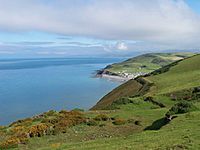
Aberystwyth is on the west coast of Wales, where the River Ystwyth and River Rheidol meet. The town has a pier and a seafront that stretches along the coast. The beach is split into two parts by the castle.
The town is made up of several areas: Aberystwyth town, Llanbadarn Fawr, Waunfawr, Trefechan, and Penparcau.
Aberystwyth is quite far from other big cities in the UK. For example, Swansea is about 70 miles away, and Cardiff, the capital of Wales, is over 100 miles away. London is about 210 miles from Aberystwyth.
 |
Cardigan Bay | Clarach, Borth, Ynyslas, Aberdyfi, Tywyn, Dolgellau, Porthmadog, Caernarfon, Bangor | Waunfawr, Penrhyncoch, Comins Coch, Bow Street, Talybont, Machynlleth, Welshpool, Oswestry, Wrexham |  |
| Cardigan Bay | Llanbadarn Fawr, Ponterwyd, Llangurig, Llanidloes, Newtown, Shrewsbury, Telford, Birmingham | |||
| Cardigan Bay | Trefechan, Penparcau, Llanrhystud, Aberaeron, New Quay, Cardigan, Lampeter, Carmarthen, Swansea, Cardiff | Llanilar, Pontrhydfendigaid, Devil's Bridge, Tregaron, Rhayader, Llandrindod Wells, Hereford |
How Aberystwyth is Governed
Aberystwyth has two main levels of local government: the Aberystwyth Town Council and the Ceredigion County Council. The Town Council works from Neuadd Gwenfrewi, a building that used to be a church.
The County Council handles most big local government tasks. However, the Town Council looks after things like cycle paths, public footpaths, CCTV cameras, public Wi-Fi, bus shelters, parks, gardens (including the castle grounds), and allotments (small plots of land for gardening). The Town Council also helps promote tourism and local businesses.
Representing Aberystwyth in Government
- Senedd (Welsh Parliament): Aberystwyth has five members in the Senedd. One is elected directly for the Ceredigion area, and four are elected from a regional list for Mid and West Wales.
- UK Parliament: For elections to the UK Parliament, Aberystwyth is part of the Ceredigion Preseli area. Since 2017, the MP for this area has been Ben Lake.
Culture and Arts in Aberystwyth
Libraries and Archives
Aberystwyth's first public library opened in 1874. In 1905, a new Carnegie library was built with a grant of £3,000. Today, the town library is located in the Aberystwyth Town Hall, which was renovated in 2012.
The National Library of Wales is in Aberystwyth. It's the national legal deposit library for Wales, meaning it gets a copy of every book published in the UK and Ireland. It was set up in 1907 and is considered one of the world's great libraries. The Welsh language is very important here, and the library offers services in both Welsh and English.
Arts and Music Scene
The Aberystwyth Arts Centre is one of the biggest and busiest arts centres in Wales. It has a theatre, a concert hall, a cinema, and art galleries. It's a great place to see shows, movies, and art. Arad Goch is another local theatre and art gallery that focuses on community arts.
Aberystwyth also has a lively music scene. The University Music Centre offers many programs for musicians and singers. The University's chamber choir, The Elizabethan Madrigal Singers, has been performing in the town since 1950. Aberystwyth is also the name of a famous hymn tune composed by Joseph Parry.
Sports in Aberystwyth
Aberystwyth has several sports clubs:
- Rugby: Aberystwyth RFC is the local rugby union club.
- Football: Aberystwyth Town F.C. is a semi-professional football club that plays in the Cymru Premier, Wales's top football league.
- Other Sports: The town also has a cricket club, an athletics club, and a boxing club. The local golf course opened in 1911.
The Welsh Language in Aberystwyth
Ceredigion, the county where Aberystwyth is located, has a high number of Welsh speakers. However, Aberystwyth itself has become more English-speaking over time, especially since it grew as a tourist town and with the university attracting many English-speaking students.
In 2001, about 39% of people in Aberystwyth said they could speak, read, or write Welsh. This is lower than the rest of Ceredigion (54%) but higher than Wales as a whole (19%).
Churches in Aberystwyth
The main Anglican church in Aberystwyth is St Michael's and All Angels. It was built between 1886 and 1890 in a Gothic Revival style.
Besides the Anglican churches, there are several other Christian churches in Aberystwyth, including Welsh Calvinistic Methodist chapels, a Wesleyan Methodist church, and an Independent Baptist church.
Education in Aberystwyth
Schools for Young People
Aberystwyth has two comprehensive schools for older students:
- Ysgol Gyfun Gymunedol Penweddig: This school teaches mainly in Welsh.
- Ysgol Penglais School: This school teaches in English, with Welsh as a subject.
There are also three primary schools in the town: Plascrug, Saint Padarns (a Roman Catholic school), and Ysgol Gymraeg. Ysgol Gymraeg was the first school in Wales to teach mainly in Welsh, starting in 1939.
Aberystwyth University
Aberystwyth University is a very important part of the town. Its original college, University College Wales, was founded in 1872. Before this, there were very few places in Wales where you could get a university degree.
Tourism and Jobs in Aberystwyth
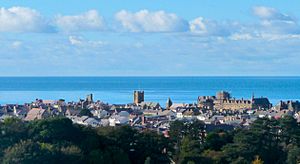
Aberystwyth is a great place for tourists, with two cinemas and a golf course. Some of the main attractions include:
- The Aberystwyth Cliff Railway, a funicular railway.
- A Victorian camera obscura at the top of Constitution Hill.
- The Vale of Rheidol steam railway that goes to Devil's Bridge.
- Aberystwyth Arts Centre.
- The Parc Penglais nature reserve.
- The Ystwyth Trail cycle path.
- The National Library of Wales.
- Park Avenue, the football stadium for Aberystwyth Town F.C..
The largest private employer in Aberystwyth is Rachel's Organic, a company that makes organic dairy products. The Cambrian News newspaper, which covers news for mid, west, and north Wales, also has its offices here.
The TV show Hinterland is filmed in and around Aberystwyth, which has made the area even more popular for tourists who want to visit the filming locations.
Getting Around Aberystwyth: Transport
Trains
Aberystwyth railway station is in the town centre. It's the end of the beautiful Cambrian Line. Transport for Wales Rail trains run almost every hour to Shrewsbury and then on to Birmingham International. You can also connect to other parts of Wales from here.
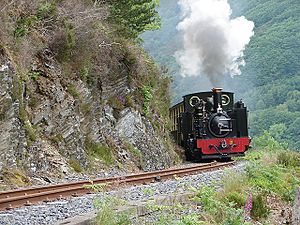
Aberystwyth station is also where the Vale of Rheidol Railway starts. This is a steam-powered narrow gauge train that takes passengers on a 12-mile journey through the stunning Rheidol Valley. It was built in 1901 to transport lead but quickly became popular with tourists.
The Aberystwyth Cliff Railway, built in 1896, is a funicular railway that takes people up Constitution Hill.
Buses
Aberystwyth is a main stop for the TrawsCymru bus network, which connects different parts of Wales. You can catch buses to:
- Carmarthen (T1 service)
- Cardiff (T1C express coach)
- Bangor (T2 service)
- Haverfordwest (T5 service)
There are also local bus services within the town and a National Express coach service to London.
Roads
The A44 and A487 roads meet in Aberystwyth, bringing a lot of traffic through the town. The A4120 road helps traffic bypass the town centre. The B4574 mountain road, which links Aberystwyth to Rhayader, is known as one of the most scenic drives in the world!
Port
Today, the port of Aberystwyth is small. But in the past, it was a very important port for trade, especially for shipping lead from local mines. Because of its history as a port, a lifeboat has been based in Aberystwyth since 1843 to help with sea rescues. The RNLI (Royal National Lifeboat Institution) took over the service in 1861.
Famous People from Aberystwyth
Aberystwyth in Stories
Games
- The PlayStation game Koudelka is set in a fictional monastery in Aberystwyth.
- In the Classic Battletech universe, a star system is named Aberystwyth.
Books
- Stripping Penguins Bare by Michael Carson is set in the town and university in the 1960s.
- Local writer Niall Griffiths sets many of his novels, like Grits and Sheepshagger, in Aberystwyth, showing a grittier side of the town.
- Nancy Bond's A String in the Harp is set near Aberystwyth, with a character working at the university.
- In The Meaning of Liff by Douglas Adams, an "Aberystwyth" is described as "A nostalgic yearning which is in itself more pleasant than the thing being yearned for."
Television
- Y Gwyll (also known as Hinterland in English), a Welsh TV show, is set and filmed in and around Aberystwyth.
Honors for Aberystwyth
Freedom of the Town
The "Freedom of the Town" is a special honor given to important people or military units. Here are some who have received it in Aberystwyth:
Individuals
- 1912 – Sir John Williams
- 1912 – David Davies
- 1912 – Stuart Rendel
- 1922 – David Lloyd George
- 1923 – Lewis Pugh Evans
- 1923 – Matthew Vaughan-Davies
- 1923 – Sir Herbert Lewis
- 1928 – Stanley Baldwin
- 1936 – Sir David Charles Roberts
- 1936 – Ernest Vaughan
- 1951 – Winston Churchill
- 2011 – Fritz Pratschke
- 2015 – Jean Guezennec
Military Units
- 1955 – The Welsh Guards
Sister Cities
Aberystwyth is twinned with these towns:
- Arklow in Wicklow, Ireland
- Kronberg im Taunus in
 Hesse, Germany
Hesse, Germany - Saint-Brieuc in
 Brittany, France
Brittany, France - Esquel in Patagonia, Argentina
See also
 In Spanish: Aberystwyth para niños
In Spanish: Aberystwyth para niños


